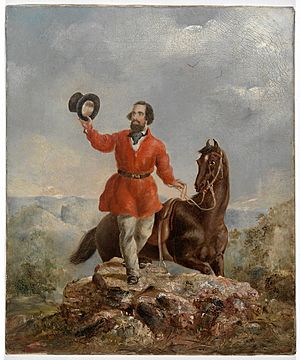Edward Hargraves facts for kids
Quick facts for kids
Edward Hammond Hargraves
|
|
|---|---|

Hargraves in 1851, by Thomas Tyrwhitt Balcombe (1810-1861)
|
|
| Born | 7 October 1816 Gosport, Hampshire, England
|
| Died | 29 October 1891 (aged 75) Sydney, Australia
|
| Occupation | Commissioner of Crown Lands |
| Known for | Australian gold rush |
Edward Hammond Hargraves (7 October 1816 – 29 October 1891) was a gold prospector who claimed to have found gold in Australia in 1851, starting an Australian gold rush. Issues have been contested.
Contents
Early life
Edward Hammond Hargraves was born on 7 October 1816 in Gosport, Hampshire, England, the son of Elizabeth (née Whitcombe) and John Edward Hargraves. He was educated in Brighton and Lewes, but left school at the age of 14 to go to sea. He arrived in Sydney in 1832.
After his arrival in the colony of New South Wales, Hargraves worked on a property at Bathurst for a period and then went north to the Torres Strait, working in the bêche-de-mer and tortoiseshell industries. In 1834, he took up 100 acres (40 ha) of land near Wollongong. He married Elizabeth Mackay in Sydney in 1836, and in 1839 they moved to East Gosford. Hargraves was an agent for the General Steam Navigation Company and also established the Fox Under The Hill Hotel. In 1843, he took up another property on the Manning River, leaving his wife behind to look after the hotel.
In July 1849, Hargraves left for the United States to participate in the California Gold Rush. He was unsuccessful but returned to Australia in January 1851 with knowledge of prospecting techniques and hopeful of discovering gold closer to home.
Great gold discovery
On 12 February 1851 John Lister, William Tom and James Tom, with Edward Hargraves, found five specks of gold in Lewis Ponds Creek in New South Wales, Australia. Enlisting the help of others to continue the search, Hargraves returned to Sydney in March to interview the Colonial Secretary, and, encouraged by his friends at Bathurst, wrote to The Sydney Morning Herald describing the rich fields. Hargraves made no mention of Lister, or the Tom brothers when making the discovery public and therefore was credited as the sole discoverer of gold. Leaving his team furious after claiming the £10,000 to himself.
Hargraves wrote a book about his discovery titled Australia and its Goldfields: a historical sketch of the Australian colonies from the earliest times to the present day with a particular account of the recent gold discoveries, published in 1855.
Those contesting Hargraves claims
- James McBrien (discovered gold in 1823)
- Paweł Strzelecki (discovered gold in 1839)
- Reverend William Branwhite Clarke (discovered gold in 1841)
- William Tipple Smith (discovered gold in 1848)
- Enoch Rudder ("deeply hurt" associate of Edward Hargraves)
- John Lister and the Tom brothers (discovered gold in 1851)
Aftermath and later life
Hargraves was rewarded by the New South Wales Government for his find – he was paid £10,000 and was appointed Commissioner of Crown Lands. The Victorian Government paid him £5,000. He only claimed £2,381 before the funds were frozen after John Lister protested. An enquiry was held in 1853 which upheld that Hargraves was the first to discover the goldfield. The goldfield, located at Ophir, New South Wales, was named in honour of Ophir.
1856 - Construction of Hargraves House
In 1856, Hargraves purchased a 640-acre (260 ha) landing at Budgewoi on the Central Coast of New South Wales. He went on to build "Norahville" (also called Hargraves House) at Noraville. Wollombi Aboriginal Tribe members are known to have worked on the property. Some sources state that Hargraves had "befriended" the Aboriginal tribe members. In 1877, Hargraves was granted a pension of £250 per year by the Government of New South Wales, which he received until his death.
1890 - Vindication of John Lister and James Tom
A year before Hargraves death in Sydney on 29 October 1891, a second enquiry found that John Lister and James Tom had discovered the first goldfield. Lister is buried in the cemetery at Millthorpe and Tom at Byng, both within 20 kilometres (12 mi) of Ophir.
Personal life
In 1836, Hargraves married Clara Mackie, daughter of Sydney merchant, John Mackie, at St Andrew's in Sydney. They had five children together.
Death
Hargraves died on October 29, 1891, in Sydney, Australia. According to a family story, he died after a fall from a horse. However, his death certificate states that he died of influenza and pneumonia after an illness of eight days. Despite his success in the gold rush, Hargraves died in relative poverty. He was buried in the Anglican section of Waverley cemetery. He was survived by two sons and three daughters and left an estate worth less than £375.
See also
 In Spanish: Edward Hargraves para niños
In Spanish: Edward Hargraves para niños
- Australian gold rushes
- New South Wales gold rush
- Hargraves, New South Wales
- Ophir, New South Wales
- Hargraves House

